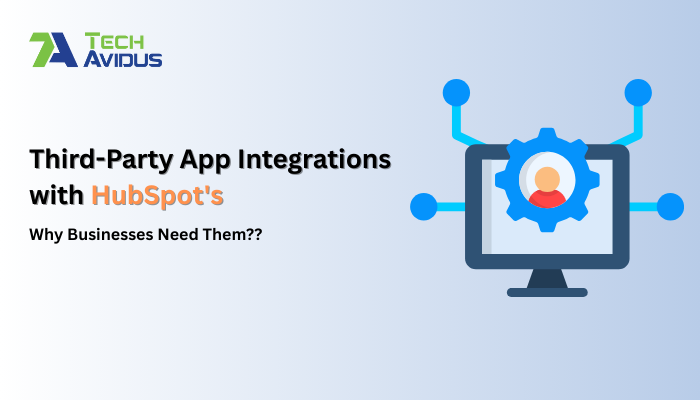
HubSpot is a powerful CRM software that helps businesses manage customer relationships, sales pipelines, and marketing campaigns. It offers a user-friendly interface, automation features, and comprehensive analytics, enabling organizations to streamline processes and drive growth.
As businesses expand, they frequently adopt various software and tools for managing operations. Integrating these tools with HubSpot enables streamlined processes, enhanced efficiency, and comprehensive business insights. This article explores integrating third-party apps with HubSpot, providing a comprehensive understanding of the process.

Integrating third-party apps with HubSpot typically involves leveraging the HubSpot API and the capabilities provided by the app's developer. Here's a general guide on how to integrate HubSpot with a third-party app:
Identify the Integration Requirements: Understand the specific requirements and goals of the integration. Determine what data you want to sync between HubSpot and the third-party app, such as contacts, leads, deals, or custom objects.
Review HubSpot API Documentation: Familiarize yourself with the HubSpot API documentation to understand the available endpoints, authentication methods, and data structures. The documentation can be found at developers.hubspot.com.
Investigate Third-Party App Integration Options: Research the documentation or developer resources provided by the third-party app to determine if they offer any pre-built integration options or APIs. Look for documentation related to authentication, endpoints, and data formats.
Create an Integration in HubSpot: In your HubSpot account, navigate to the Integrations section and look for the app you want to integrate. Follow the instructions to set up the integration. That may involve generating API keys or configuring authentication settings.
Configure the Third-Party App: Depending on the app, you may need to configure settings or provide authentication credentials. Refer to the app's documentation for guidance on how to set up the integration on their side.
Develop the Integration: Develop the integration logic using the HubSpot API and the third-party app's API. That may involve writing code in a programming language of your choice or using tools like Zapier or Integromat to create automated workflows.
Test and Iterate: During the development process, thoroughly test the integration to ensure data is synchronized correctly between HubSpot and the third-party app. Make any necessary adjustments or improvements based on testing results.
Handle Errors and Exceptions: Implement error handling mechanisms to handle scenarios where the integration encounters errors or fails to sync data properly. Consider implementing logging and monitoring to track any issues that may arise.
Businesses can greatly benefit from integrating third-party apps with HubSpot for the following reasons:
Expanded Functionality: HubSpot provides a robust set of features, but integrating third-party apps allows businesses to access additional specialized tools and functionalities not native to HubSpot. That enables businesses to customize and tailor their CRM platform to their specific needs. For example, integrating email marketing tools or social media management platforms can enhance marketing automation capabilities and enable businesses to execute more targeted and effective campaigns.
Streamlined Workflows: Integrating third-party apps with HubSpot enables businesses to automate tasks and streamline workflows. Data can be synchronized, shared, and transferred automatically by connecting different systems, reducing manual effort and minimizing errors. That streamlines lead generation, data entry, customer support, and reporting, improving overall operational efficiency.
Data Synchronization and Accuracy: Integrating third-party apps ensures that data remains consistent and up-to-date across different systems. That eliminates the need for manual data entry or duplicate record-keeping, reducing the risk of errors and inconsistencies. Having accurate and synchronized data provides businesses with a single source of truth, enabling them to make informed decisions based on reliable and complete information.
Improved Customer Insights: Third-party app integrations can bring in additional data sources and enrich the customer insights available in HubSpot. For example, integrating with customer survey tools or website analytics platforms can provide a more profound understanding of customer behavior and preferences. This enhanced data allows businesses to segment their audience, personalize marketing campaigns, and deliver more targeted and relevant content, ultimately improving customer satisfaction and engagement.
Enhanced Collaboration: Integrating third-party apps encourages collaboration and alignment between different teams and departments. For instance, integrating HubSpot with project management or customer support tools enables seamless communication and coordination between sales, marketing, and customer service teams. This collaboration fosters a unified approach to customer interactions, promotes teamwork, and ensures a consistent customer experience across various touchpoints.
Scalability and Adaptability: Third-party app integrations offer businesses the flexibility to scale their CRM capabilities as their needs evolve. As businesses grow or their requirements change, they can easily integrate new tools or switch to different apps that better suit their evolving needs. This scalability and adaptability allow businesses to future-proof their CRM strategy and ensure their technology stack can support their long-term growth plans.
By integrating third-party apps with HubSpot, businesses can leverage a broader range of functionalities, streamline workflows, access comprehensive customer insights, enhance collaboration, and adapt their CRM system to their specific requirements. These integrations help businesses drive growth, improve customer relationships, and stay competitive in their respective markets.
At TechAvidus, we have extensive experience integrating various systems with HubSpot, including custom applications, third-party platforms, and existing software solutions. Our skilled developers and integration specialists can analyze your tech-stack requirements, devise a comprehensive integration strategy, and seamlessly connect your systems with HubSpot.
Our integration services encompass one-way and two-way integrations, allowing you to sync data between HubSpot and your existing software in real-time. Whether you need to integrate customer data, sales leads, marketing campaigns, or any other crucial information, we can create a customized solution tailored to your business needs.
If you're ready to unlock the full potential of HubSpot by integrating it with your tech stack, TechAvidus is here to help. Contact us today to discuss how we can create a robust and efficient integration solution tailored to your business goals.
Our Top 1% Tech Talent integrates cutting-edge AI technologies to craft intelligent, scalable, and future-ready solutions.
All Rights Reserved. Copyright © 2025 | TechAvidus